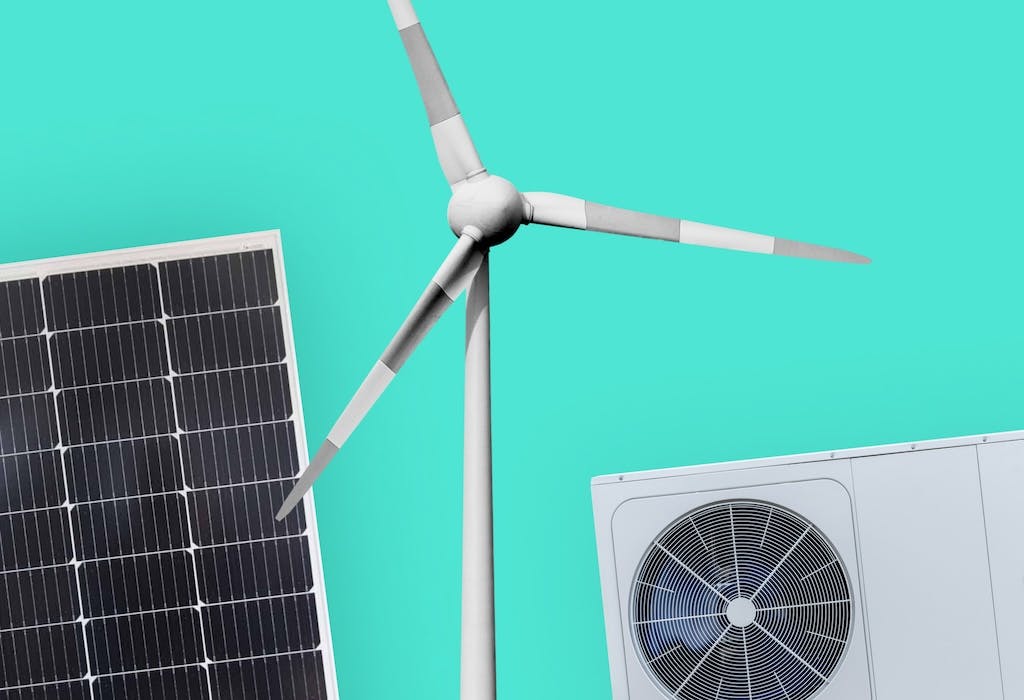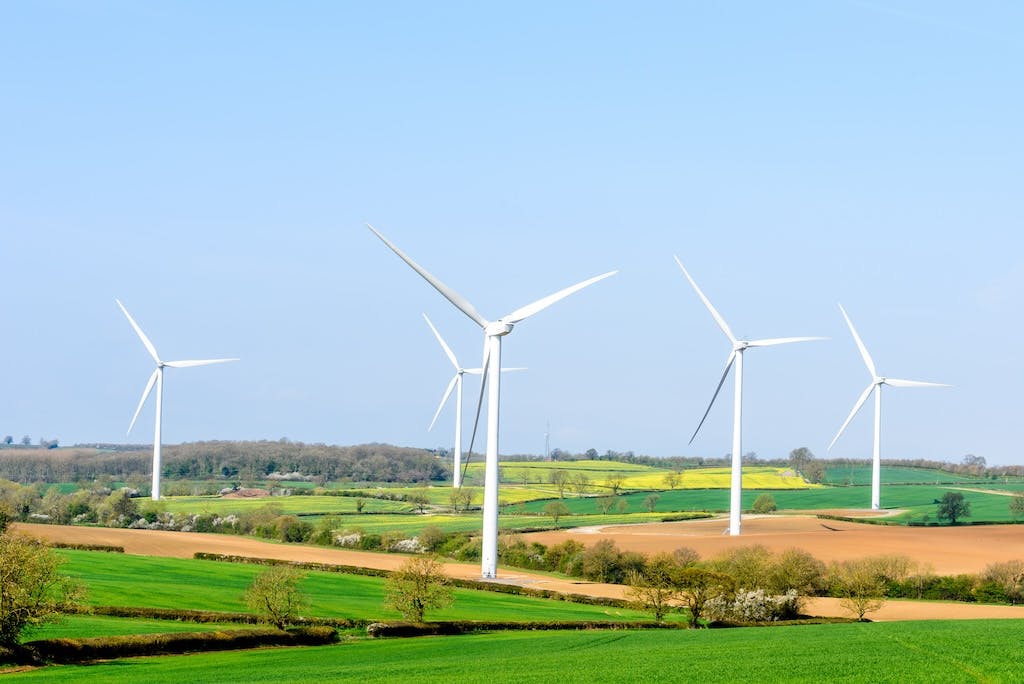The five best types of renewable energy
Find out the ultimate top five sources of renewable energy based on cost, efficiency, accessibility and more.
Written byJoanna Hunter

Calculate savings
What kind of home do you live in?
Calculate savings
What kind of home do you live in?
☀️ Solar is the world’s cheapest source of renewable energy, at $876 per kilowatt
🌊 Hydroelectric power is the most efficient source of renewable energy
💨 Of all renewable sources, wind contributes the most to the UK’s electricity mix
The world is enduring an ongoing climate crisis and renewable energy is one way to slow the whole thing down. However, every source of renewable energy has its own unique advantages and disadvantages - for instance, some are cheap but very dependent on location, whilst some are enormously expensive but a lot more versatile.
In this article, we’ll run through the five best five types of renewable energy based on efficiency, cost, and accessibility. And we’ll also explore how popular each one is in the UK.
What is the best type of renewable energy?
There’s no ultimate ‘best’ type of renewable energy, because it depends on so many different factors. For instance, the best renewable energy for a hot, dry country that has no coast line would be very different to a wet, windy island nation (e.g. the UK).
However, if we break it down into categories, there are some clear winners. Hydroelectric power is the most efficient (at 90% or higher), while solar energy is the cheapest (at $876 per kilowatt) and also the most accessible to households (to learn more, check out our guide to solar panel costs).
Specifically in the UK, wind energy is unsurprisingly the most. Our geography is perfectly suited to it, and in 2022 wind turbines covered almost one quarter of the country’s electricity needs.
To learn more, check out our guide to how much renewable energy the UK uses.
The 5 best types of renewable energy
In no particular order, here’s our rundown of the five best sources of renewable energy right now.
Solar energy
Solar energy works by converting natural light into electricity, making use of strategically placed solar panels to get as much exposure to daylight as possible. When light particles (called photons) hit a solar panel, an electric charge is created, resulting in electricity.
Electricity is then converted from direct current (DC) to alternating current (AC), which allows it to be used at home.
Crucially, solar panels only need daylight to work effectively - not direct sunlight - so they generate electricity even on cloudy days.
Whilst the manufacture of solar panels has a carbon footprint, the clean electricity produced during each panel’s lifetime obviously makes up for this.
Also, at the end of a solar panel’s useful life it can be broken down and recycled - although there is currently only one place in the UK that can do this (in Scunthorpe).
Solar power is the cheapest renewable energy on this list, costing just $876 per kilowatt produced worldwide in 2022, which makes sense, since solar panels are cheaper than they've ever been.
In terms of domestic applications, a 4.5kWp solar panel system (the right size for a three-bedroom property) will cost around £10,300, including installation.
How efficient are solar panels?
Solar panels are getting more efficient all the time, with recent efficiency records hitting over 40%. However, most household solar panels range between 15% and 23%. This is pretty low compared to other sources of renewable energy, but nothing beats solar when it comes to accessibility on a domestic scale.
How popular is solar in the UK?
In the UK there are over 1.2 million households with solar panels, which equates to roughly 4% of the country’s housing stock. The energy crisis naturally triggered a huge spike in demand for solar, and the Guardian reports that there were more than 17,000 domestic solar installations in each month of 2023.
However, in 2022 just 4.4% of the national grid’s electricity came from solar, which is very small compared to other renewable sources - such as wind (at 23.3%).
To learn more, check out our rundown of the top 13 countries for solar energy consumption.
Wind energy
The best location for wind turbines is ultimately where the wind blows the most, which is typically offshore. The process is very simple: the wind’s kinetic energy moves the turbines’ blades, which drives a generator.
Some people have voiced concerns about the noise created by a wind turbine, but the level of disturbance is exaggerated. Today, a wind farm operating 750 feet away is the same volume as a kitchen fridge, and this noise is usually masked by the sound of the wind itself. There are also concerns that wind turbines kill birds, however not nearly as many as those killed by fossil fuel projects - as the MIT Climate Portal reports.
The manufacture of the turbines themselves obviously has a carbon footprint, but once a wind turbine is in place the electricity it generates is entirely green.
In most cases, wind energy is generated on an industrial scale, but it is still possible to use at home with small, roof-mounted wind turbines. The main issue is that planning regulations are strict, and also you need to live in a particularly windy area for it to be worthwhile.
In 2022, the global cost of wind energy was $1,274 per kilowatt, which makes it the second cheapest on the list. Turbine costs range widely depending on the application; a small domestic turbine will cost just a few hundred pounds, whereas an industrial turbine can cost millions.
How efficient is wind energy?
Wind turbines need a wind speed of nine mph or more to be effective. The United States Environmental Protection Agency estimates that wind turbines work at an efficiency of 20-40%.
How popular is wind energy in the UK?
In 2022, wind made up 26.8% of the UK’s energy generation, making it the UK’s primary source of renewable energy. There are now nearly 11,500 wind turbines in the UK, the majority of these being onshore (although it’s the offshore wind farms that generate more electricity, due to bigger turbines and more wind).
Unfortunately, the UK sometimes experiences dunkelflaute events, which are periods of low wind and little sunlight, and in these instances it's tricky to rely on wind turbines (and solar panels). However, there are many solutions to this, including a more diverse range of renewable energy sources, and storing electricity in batteries for later use.

Hydroelectric energy
Hydroelectric energy is the generation of electricity from moving water. This might include the power of the tides, or the momentum generated by waterfalls. It also covers man-made bodies of water, including reservoirs and dams.
The creation of some of the man-made water features – and the infrastructure required to maintain them – has a carbon footprint, and it can also lead to widespread disruption of human habitats and wildlife.
You can set up a hydroelectric system at home, but it requires access to a body of water that you have permission to use – which, for most people, is a high bar.
Hydroelectric power is much more expensive than solar and wind, with its global cost per kilowatt in 2022 coming in at $2,881. On a domestic scale, the Centre for Alternative Technology estimates a 1 kilowatt (kW) battery-charging system would cost between £5,000 and £6,000, excluding installation.
How efficient is hydroelectric energy?
Modern hydroelectric energy is extremely efficient, with an efficiency rating of 90% or higher. Compared to solar (approx. 20%) and wind (approx 30%), hydroelectric is phenomenally efficient.
How popular is hydroelectric energy in the UK?
Just 1.8% of the UK’s electricity generation comes from hydroelectric power, making it smaller than wind and solar. However, the use of hydroelectric has grown significantly in the past couple of decades, with the number of hydro facilities increasing by more than five-fold between 2003 and 2022.
Geothermal energy
Geothermal energy is electricity generated from the natural heat beneath the surface of the earth. There is a lot of thermal energy stored in the rocks and fluids in the centre of our planet, which is constantly escaping out to the surface. Hot water is drawn from deep underground using high pressure, and then once the pressure drops it turns into steam. The steam then turns a turbine which generates electricity.
The construction of piping systems and digging of boreholes is an intensive industrial process that leaves a carbon footprint, but the clean electricity generated makes up for this.
However, geothermal plants can sometimes create small earthquakes, as well as small quantities of air and water pollutants. These plants also require large amounts of water for cooling.
It is possible to have a domestic geothermal system (known as a ground source heat pump), but this is a bit different to the large-scale industrial process. On a residential scale there’s no steam, no turbine, and no electricity generation - instead, the pump extracts warmth from the earth and uses this to heat water on the surface.
Geothermal energy is the most expensive renewable energy source in this list, costing a whopping $3,478 per kilowatt in 2022. Domestic geothermal costs are similarly pricey, with the Energy Saving Trust estimating that a ground source heat pump will set you back somewhere between £28,000 and £49,000.
How efficient is geothermal energy?
A global review of geothermal plants revealed that the average efficiency is 12%, although it has the potential to reach around 21%. In contrast, a domestic ground source heat pump can reach efficiencies of 300-400%, although this efficiency refers to heat generation as opposed to electricity generation.
How popular is geothermal energy in the UK?
The role of geothermal energy in the UK’s green transition is extremely small. In terms of electricity generation geothermal energy contributes precisely 0%, and in terms of heat demand it covers just 0.3% of the UK’s annual demand.
Natural occurrences of geothermal activity (e.g. hot springs) have always been a huge attraction, but geothermal as a broader energy source is limited: the US is the world’s largest user, but even there it makes up only 0.4% of total electricity generation.
Biomass energy
Ever since humans discovered fire, biomass has been a source of energy. On a small scale, biomass is usually the burning of plants or wood, but at an industrial level it can involve the incineration of domestic or agricultural waste, or crops that have been specifically grown for the purpose of burning.
However, whilst biomass energy is renewable, it is arguably not sustainable. This is because there is carbon dioxide released whenever organic matter is burnt, making it the only source of energy in this list that doesn’t create clean electricity.
There is also the issue of the infrastructure required to use it at scale, and the fact that intensive biomass, even on a domestic scale, can quickly lead to deforestation.
On a cost level, biomass is also not particularly cheap. In 2022, the global average installation cost per kilowatt was $2,162, which is only a few hundred dollars less than hydroelectric.
How efficient is biomass energy?
While modern biomass plants have been engineered to achieve efficiencies of up to 40%, the domestic efficiency of biomass tends to be 2-3% because so much heat is lost as the fuel burns.
How popular is biomass energy in the UK?
In 2022, biomass energy contributed 5.2% to the UK’s national electricity mix, which is better than solar, hydroelectric, and geothermal - but not as strong as wind.
The UK produces about 65% of the fuel it burns for biomass energy, and it imports the remainder from other countries.
What’s the cheapest type of renewable energy?
Of the five key sources of renewable energy, solar is the cheapest. Check out the table below for a rundown of the costs.
| Type of renewable energy | Average cost per kilowatt in 2022 |
|---|---|
| Solar | |
| Wind | |
| Biomass | |
| Hydroelectric | |
| Geothermal |
The best renewable energy: FAQs
What is the number one renewable energy?
This depends on whether the focus is on cost, efficiency or domestic accessibility.
Solar is the cheapest and the most accessible to households, but hydroelectric power is the most efficient (at 90% or higher).
According to the United Nations, hydroelectricity is the most widely used renewable energy worldwide - accounting for 60% of global renewable electricity generation.
What is the best type of renewable energy in the UK?
Wind, both onshore and offshore, contributes more to the UK’s electricity production than any other source of renewable energy.
This is because the UK’s island geography creates ideal locations for wind turbines.
Which renewable energy source is the most sustainable?
Wind, solar, geothermal and hydroelectric are all equally sustainable, given that they all draw on sources that are not likely to expire any time soon.
In contrast, biomass energy creates a lot of carbon dioxide in the process of generating electricity, which makes it far less sustainable.
To learn more, check out our rundown of renewable energy facts.
Is nuclear power a renewable energy source?
While nuclear power is considered key to the National Grid’s ambition of achieving Net Zero by 2050, it cannot be classed as a renewable energy.
This is because nuclear energy requires uranium – and, like fossil fuels, there is a finite amount. According to the Nuclear Innovation Alliance, there is enough uranium to supply 100 years of current demand.

Written byJoanna Hunter
Joanna has been a freelance writer for the past 20 years, after working as a commissioning editor at The Times until 2004. Based in London, she has written for global publications and brands, consulted for companies ranging from environmental startups to Tesco, and has seen her work published in The Guardian, The Spectator, Elle, The Sunday Times, Conde Nast Traveller, and others.